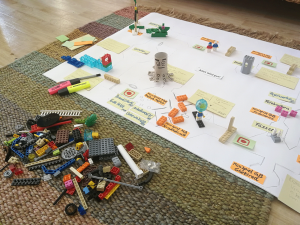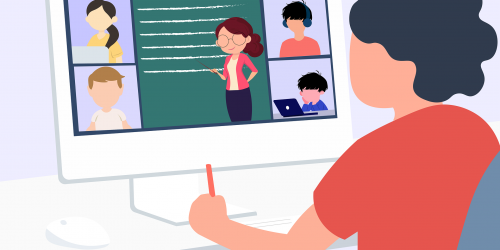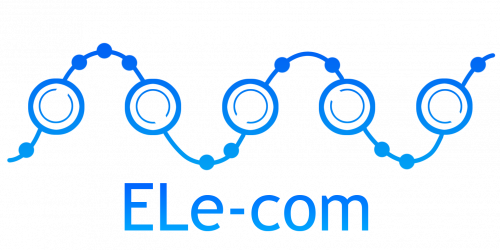From the analogue toilet paper roll to the digital learning game – how creative collaboration can also be achieved from the home office
As part of the ESF-funded EFA project The project team at the Media Center of the TU Dresden is developing a digital learning game for occupational health and safety in the social services sector. A wide variety of creative methods, tools and workflows are used in the individual development phases. The conception phase in particular, in which learning content is translated into game scenarios on the one hand and typical game elements such as a game story around the protagonists are developed on the other, is designed for creative team work. While before the Corona pandemic, the specially set up creative lab worked with materials such as paper/cardboard, toilet paper rolls, Post-Its, Lego bricks and small figures and many ideas were generated in creative workshops, the work is now somewhat different. The project team is currently faced with the challenge of exploiting the creative potential that working in the creative lab held in the digital space.
 Creating creative spaces in the home office also requires creativity. To meet this challenge, the EFA team uses a wide range of digital, non-digital and organizational tools. To further develop the game ideas, the concept team now meets exclusively in virtual space, for which video conference platforms or virtual whiteboards are used and also tested for creative work. In order to make the web conferences as efficient as possible, each team member first comes up with creative ideas for implementing the game content while working from home. In the subsequent virtual meetings, these ideas are presented, discussed and summarized into a common solution. Prototypical game environments are created as sketches, using Lego or on paper. The hands-on prototype in the living room at home can also invite spontaneous co-creation sessions with roommates, children or partners. Why not develop ideas about the fate of the octopus, who suffers from chronic stress and overload, together with others despite working from home?
Creating creative spaces in the home office also requires creativity. To meet this challenge, the EFA team uses a wide range of digital, non-digital and organizational tools. To further develop the game ideas, the concept team now meets exclusively in virtual space, for which video conference platforms or virtual whiteboards are used and also tested for creative work. In order to make the web conferences as efficient as possible, each team member first comes up with creative ideas for implementing the game content while working from home. In the subsequent virtual meetings, these ideas are presented, discussed and summarized into a common solution. Prototypical game environments are created as sketches, using Lego or on paper. The hands-on prototype in the living room at home can also invite spontaneous co-creation sessions with roommates, children or partners. Why not develop ideas about the fate of the octopus, who suffers from chronic stress and overload, together with others despite working from home?
Once the game concept for the next section of the learning game has been created, this too must be extensively tested before the digital implementation can begin. But how can you manage to move a paper-based test game into the digital space? Here, too, the EFA team is already working on ideas for testing a video-based test game of the prototype. We are excited to master this challenge too!






